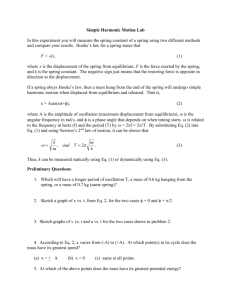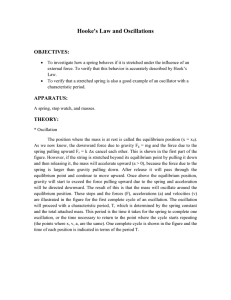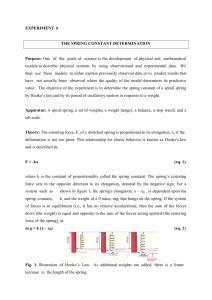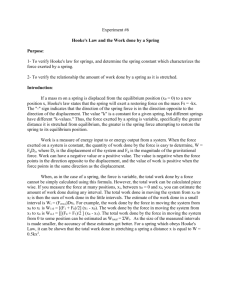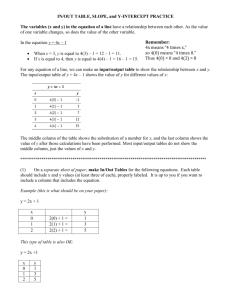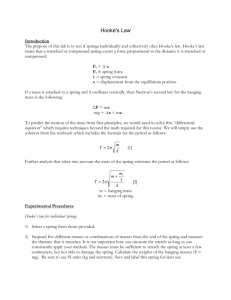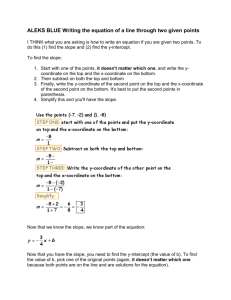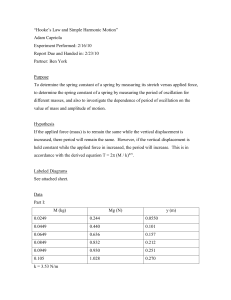PHYS 1030L Spring Constant
advertisement
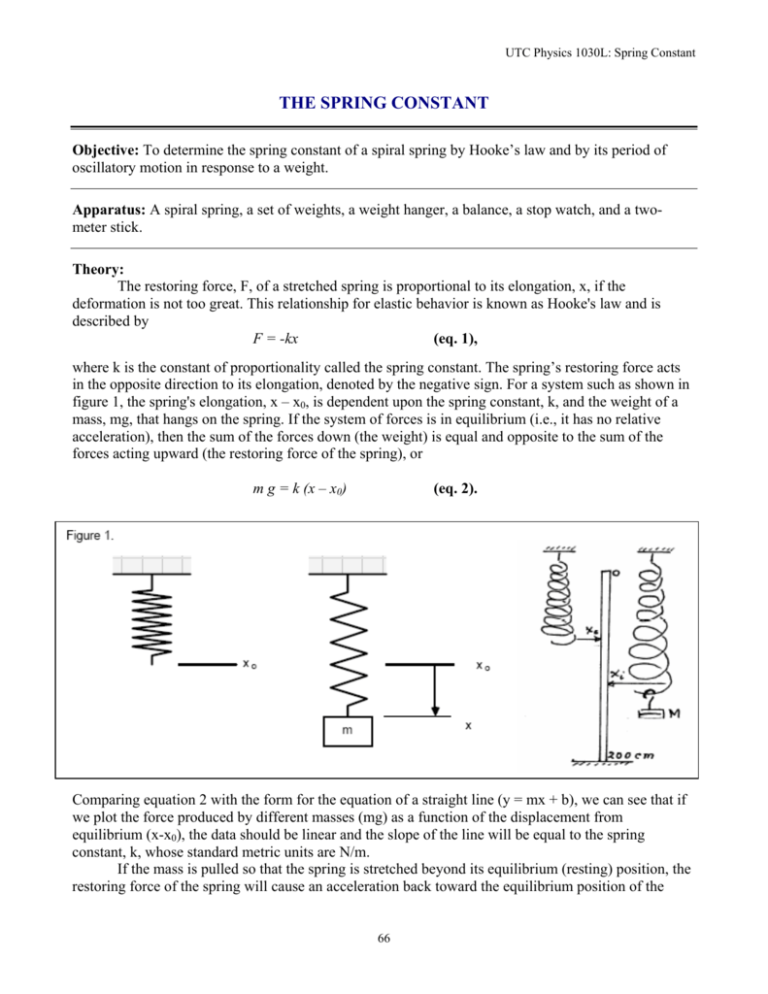
UTC Physics 1030L: Spring Constant THE SPRING CONSTANT Objective: To determine the spring constant of a spiral spring by Hooke’s law and by its period of oscillatory motion in response to a weight. Apparatus: A spiral spring, a set of weights, a weight hanger, a balance, a stop watch, and a twometer stick. Theory: The restoring force, F, of a stretched spring is proportional to its elongation, x, if the deformation is not too great. This relationship for elastic behavior is known as Hooke's law and is described by F = -kx (eq. 1), where k is the constant of proportionality called the spring constant. The spring’s restoring force acts in the opposite direction to its elongation, denoted by the negative sign. For a system such as shown in figure 1, the spring's elongation, x – x0, is dependent upon the spring constant, k, and the weight of a mass, mg, that hangs on the spring. If the system of forces is in equilibrium (i.e., it has no relative acceleration), then the sum of the forces down (the weight) is equal and opposite to the sum of the forces acting upward (the restoring force of the spring), or m g = k (x – x0) (eq. 2). Comparing equation 2 with the form for the equation of a straight line (y = mx + b), we can see that if we plot the force produced by different masses (mg) as a function of the displacement from equilibrium (x-x0), the data should be linear and the slope of the line will be equal to the spring constant, k, whose standard metric units are N/m. If the mass is pulled so that the spring is stretched beyond its equilibrium (resting) position, the restoring force of the spring will cause an acceleration back toward the equilibrium position of the 66 UTC Physics 1030L: Spring Constant spring, and the mass will oscillate in simple harmonic motion. The period of vibration, T, is defined as the amount of time it takes for one complete oscillation, and for the system described above is: T = 2π me k (eq. 3), where me is the equivalent mass of the system, that is, the sum of the mass, m, which hangs from the spring and the spring's equivalent mass, me-spring, or me = m + me-spring (eq. 4). Note that me-spring is not the actual mass of the spring, but is the equivalent mass of the spring. It is not the actual mass because not all of the mass pulls down to act in concert with the weight pulling down. Its theoretical value for our system should be approximately 1/3 of the actual mass of the spring. Substituting equation 4 into equation 3 and squaring both sides of the equation yields: 4π 2 (m + me−spring ) . T = k Expanding the equation: 4π 2 4π 2 T2 = m+ me − spring k k 2 (eq. 5). Therefore, if we perform an experiment in which the mass hanging at the end of the spring (the independent variable) is varied and measure the period squared (T2; the dependent variable), we can plot the data and fit it linearly. Comparing equation 5 to the equation for a straight line (y = mx + b), we see that the slope and y-intercept, respectively, of the linear fit is: slope = 4π 2 k and y-intercept = 4π 2 me − spring k (eq. 6). Procedure and Data Analysis: Suggestion: After taking data in part I, step 5 for a given mass, continue on to part II, right away since the same mass is used. Then repeat the same procedure with the other three masses. PART I. Determination of the spring constant by Hooke’s law. 1. Using a 2-meter stick with zero end on the top and the 200 cm (2 m) end on the floor (as shown in figure 1), read the position of the last coil of the freely hanging spiral spring and record it on your data sheet as x0. 2. Hang an approximate 0.100 kg mass to the spring. Remember to include the mass of the hanger and weigh the masses on a balance. Record this mass in column 1 on your data sheet for part I. 3. In column 2 on the data sheet, calculate the weight of the mass using F = mg, where m is in kg and g is 9.8 m/s2. 4. Read xi, the position of the same last coil of the spring as in step 1 (shown in figure 1). Record this distance in column 3 on your data sheet for part I. 67 UTC Physics 1030L: Spring Constant 5. In the fourth column on the data sheet, calculate the total displacement of the last coil of the spring, Δx, by Δx = xi – x0. 6. Repeat steps 2-5 for masses approximately equal to 0.200 kg, 0.300 kg, and 0.400 kg. 7. Make a graph of the force, F, versus displacement (Δx). You will have five data points for this graph: the four data points for each of the four masses, and an additional data point at (0,0). This data point is valid because when 0 kg hung on the spring, it was displaced 0 m from its equilibrium position. 8. Fit the data with a linear function in the form of y = mx + b. Determine the value of the spring constant from the slope of the best-fit line. In order to make a graph with a linear fit in Excel 2007: a. Label column A as your independent variable (whatever you would like plotted on the x-axis) and type in your values. Label column B as your dependent variable (which will be values plotted on the y-axis) and type in your values. b. In order to make a graph of the dependent vs. the independent variable, highlight the data in columns A and B. c. On the Insert tab and the Charts toolbar, click on Scatter. Select the Scatter with only Markers plot option (Do not connect the points with a line – this is not a best fit). d. When the graph is selected, the Chart tools appear. Under the Design tab, click on Move Chart, and select “New Sheet”. e. Add an appropriate chart title and axis titles under the Layout menu of the Chart Tools. f. Unless your data contains more than one series, highlight and delete the legend. g. Under the Chart Tools Layout tab, and the Analysis tools, click Trendline and “More Trendline Options” (shown on the next page). Select the Linear regression type and check the options for Display Equation on chart and Display R-squared value on Chart. h. The equation of the line and the estimate of the goodness of its fit (R2) should now appear on your chart. A value of R2 that is equal to 1 would indicate a perfect correlation. Print the graph. 68 UTC Physics 1030L: Spring Constant PART II. Determination of the spring constant by its period of oscillation in response to different masses. 1. Weigh the spring on a balance and record its mass on your data sheet. 2. Hang an approximate 0.100 kg mass from the spiral spring. (Be sure to record the actual mass on your data sheet for part II). 3. Start the oscillation in a vertical direction by pulling gently down on the mass and releasing it (an initial displacement of 2-3 cm works best). Measure the amount of time required for twenty complete oscillations with a stop watch, and record it as t1 on your data sheet. 4. Repeat step 2-3 three times and find the average. Record this as tavg on your data sheet. 5. Calculate T, the system's period for one oscillation, dividing tavg by 20. Record this on your data sheet. 6. Repeat step 2-5 for masses approximately equal to 0.200 kg, 0.300 kg, and 0.400 kg. 7. Calculate the values of T2 and record them in the appropriate column on your data sheet. 8. Make a graph of T2 vs. mass, m. Note: There are only four data points for this experiment. There is no (0,0) data point because a mass of 0 kg produced no oscillatory motion. 9. Fit the data with a linear function in the form of y = mx + b. The values for the slope and y-intercept correspond accordingly to the relationships given by equation 6. 10. Determine the value of the spring constant (in N/m) from the slope. 11. Determine the value for the equivalent mass of the spring, me-spring, from the value of the y-intercept and the value of k found in step 10. 12. Find the percent difference between k in part I and k in part II. 13. Find the ratio of the equivalent mass of the spring to the total mass of the spring that you weighed (me-spring/mspring). Lab Report Format: Your lab report for this experiment should contain: 1. Pre-lab (objective, theory, sketch of the experimental set up, and procedure). 2. Neatly written copy of your experimental data sheet. 3. Sample calculations: For Part I of the experiment, show a sample calculation for (1) the force due to a mass and (2) the displacement, Δx. For Part II of the experiment, show (3) an example of your calculation for T, (4) the calculation for k, and (5) the calculation for me-spring. You should also 69 UTC Physics 1030L: Spring Constant show (6) the calculation for the percent difference between the two determined values of k and for (7) the ratio of me-spring to mspring. 4. Graphs: Include your graph of (1) F vs. Δx from part I of the experiment and (2) T2 vs. m from part II of the experiment. Make sure both graphs have a title, appropriately-labeled axes with units, and a best-fit line to the data with an equation and an estimate of the goodness of fit (R2 or MSE). 5. Results: Report your results (in complete sentences) for the value of k as determined by the method using Hooke’s law and by the experiment measuring the period of oscillation of the spring. Report how well these two values agree with each other (the percent difference between the two). Also report your value for the ratio of the equivalent mass of the spring to the actual mass. How well does it agree with the theoretical value for this ratio? Make sure all values are properly rounded and have the correct number of significant digits. 6. In your conclusions, address the answers to the discussion questions below: 1. How much did your values for the spring constant differ between the two methods? Test this difference by the following: If you were to use the value obtained for k from part I of the experiment, what would the displacement of a 0.250 kg mass be if you hung it on the spring (as in Part I)? Predict the value of the displacement of a 0.250 kg mass using the value of k from part II of the experiment. How much of a difference is there? 2. In Part II of the experiment, we derived the value of a physically-significant quantity (me-spring) from the y-intercept of the graph. If you were to extend the linear fit backwards so that it intersected the x-axis, approximately what value would you get? (Read this number from an extrapolation of your best-fit line on the graph, and don’t forget the units.) Explain what physical quantity this represents and why. [Hint: Using equation 5, substitute a value of 0 for T2 (because y=0 on the x-intercept) and substitute x for m (because you are plotting m on the xaxis).] 3. Any spring contains elastic potential energy that is proportional to the distance squared that it is stretched or compressed away from its equilibrium (resting) position (EPE = ½ kx2). An object such as a mass attached to a spring has a kinetic energy that is proportional to the speed at which it moves (KE = ½ mv2). In the oscillatory motion observed in part II of this experiment, where are the two positions where the elastic potential energy of the system reaches a maximum? The position where EPE is at a minimum? Where is the kinetic energy of the object hanging on the spring at a maximum and a minimum? You may find it helpful to draw a diagram and label the positions for maximum and minimum elastic potential energy and kinetic energy. 70
